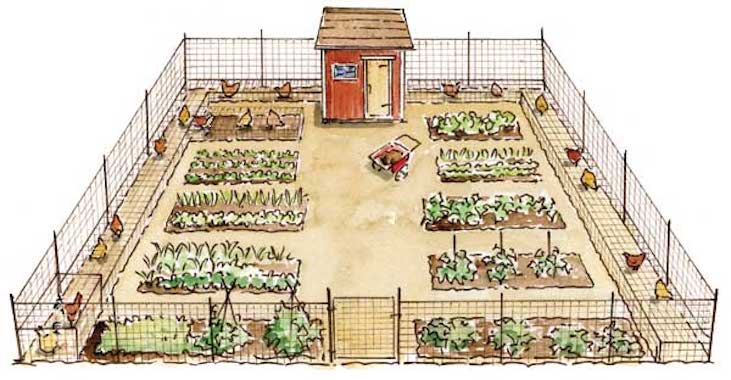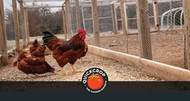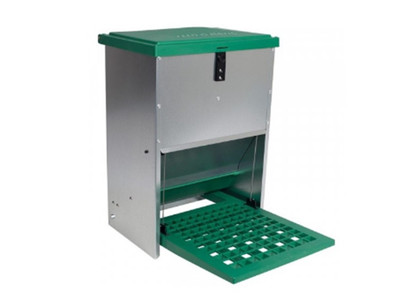A Beginner's Guide to Keeping Chickens

In recent years more and more households - both rural and urban - have decided to keep backyard chickens or poultry. As well as being a source of ‘homemade’ fresh eggs, it’s something that brings a lot of pleasure and even companionship. Chickens have a surprising amount of personality and are relatively low-maintenance, happy to potter around.
Having said that, there are some basic needs that you are obliged to provide for your flock, who will also rely on you to try and keep them safe from predators such as foxes and mink.

How Much Space Do Chickens Need?
Recommendations vary about how much space you should provide for your poultry, from 1 square foot per bird (as a bare minimum!) to 4 square feet per bird to 10 square feet (this also varies depending on whether you’re talking about space in a chicken run vs space in a coop).
The more space you can provide, the happier and freer your hens will be - and there will be less chance of inter-flock squabbling.

Chicken Coop
A chicken coop is where your flock will go to sleep or to roost. It is important that they have somewhere to shelter from bad weather conditions, and where they will be safe from predators at night. A chicken coop should have the following features:
1 - Nesting boxes or areas
This is a secluded space where a hen will go to lay her eggs. It should be dark, so it’s a good idea for these to be situated under a window so that light is not shining into them. It’s recommended that there should be one nest box for every three hens.

Chicken Nest Box - 2 Room
View Product2 - Roosting areas
This is basically where the chicken will rest or go to sleep. As bizarre as this may seem to us homosapiens, chickens like to do this when perched on a ‘roost’. This can be provided for them in the form of a narrow shelf or piece of timber elevated off the ground.
Although some chickens are known to sleep on bedding, roosting is their instinctual preference - probably because it keeps them off the ground and safer from predators.

3 - Good ventilation
Ventilation is important because chicken droppings can lead to a build-up of ammonia, which can be harmful to your flock’s health.
It’s recommended to have your coop raised off the ground. This will reduce the risk of rodent problems, and it also provides a space for chickens to shelter or seek shade. Poultry do prefer to be outside and not ‘cooped up’ so to speak during the day.

Nestomatic Roll Away Nest Box
View ProductYou can also make life a lot easier for yourself by checking that there’s an easy, spacious access point for cleaning or collecting eggs. Some coops will come with roll-away functions for eggs or boards/shelves for droppings.
You can DIY a chicken coop, but you should ensure that it’s both well-ventilated on the one hand and free from drafts on the other. It’s also important to ensure that it’s securely sealed from the outside, as foxes can be very industrious when it comes to gaining access.

Chicken Run
A chicken run refers to a fenced off area where your flock are free to roam around to their heart’s content. Ideally this fencing should be secure from predators, which means that the netting should be difficult to burrow under. See below for more info on keeping your poultry safe and secure.
A chicken run can be an extension of a coop, or it can be a wider fenced off area that the coop is placed inside of.

Enclosure with Chicken Netting - 50m
View Product Poultry and Predators
Unfortunately one thing that you need to be aware of when keeping poultry is that there are many creatures out there that see them as a potential dinner. Foxes are by far the biggest threat, and can wipe out entire flocks in just one incident. This can happen to even the most careful and conscientious poultry keeper. Your chickens and hens can also be vulnerable to attack from badgers, mink, rodents and even dogs.
A fox can be very persistent when it knows there are sources of food around. They can gain entry to chicken coops or runs by finding a small entry point (such as where shelves open out for cleaning) or by digging under fences.

They can squeeze through very small holes and gaps, so you need to check that every possible entry point is blocked off. Foxes can be a threat in urban areas as well as rural.
If you want to keep predators at bay, chicken run fencing should ideally consist of welded wire or hardware cloth, and it should be dug down into the soil for a good 6-12 inches. For good measure the wire should then point outwards and be covered with soil and large bricks, or something to weigh it down.
For extra security and peace of mind, many poultry keepers prefer to go with an electrified fence. This delivers a short sharp shock that is very effective at dissuading foxes and sending them on their way. Electric fencing can be obtained from agricultural stores.

360° Solar Animal Repeller with PIR Sensor
View ProductSome other deterrent methods include scent repellents, marking the territory with urine (seriously), or ultrasonic devices that create high-pitched noises that disturb the fox. None of these will be as foolproof as an electric fence, but they have been shown to be effective.
It's best to cause maximum confusion and disruption for the fox by combining two or more deterrent methods, with one targeting their sense of smell, another their hearing etc.

Food and Drink
Chickens don’t tend to overeat, but they can end up with bad eating habits if you feed them the wrong things. They are very partial to kitchen scraps of all kinds, but this should be a small percentage of their diet or an occasional treat. (It's also technically illegal to feed them kitchen scraps in some countries such as the UK, a regulation that dates back to the Foot and Mouth outbreak).
For good health (and healthy egg laying) they should be eating plenty of food that is high in protein. Layer pellets are the best option and are widely available. They contain a healthy balance of nutrients, vitamins and minerals. For bigger flocks it can be a good idea to have more than one chicken feeder so that no-one is being left out.

Gaun Recycled Poultry Feeder with Legs - 4kg
View ProductThe reason that a specially designed chicken feeder is preferable to a bowl or random container is that poultry can make a bit of a mess when eating: they tend to flick food into the air due to the way that they feed. This can also lead to unwanted visitors like rodents if the food remains scattered around, or if the bowls are left out unattended.
In fact, this can be a problem even with feeders that are designed for poultry. Some models will cover the feeding trough with an ‘anti-flick’ grid that the birds can dip their heads in and out of. Another alternative is the Treadle Feeder design. This will open up the feeding area when a chicken steps on a ramp; rodents won’t be able to trigger it this way.

Feedomatic Treadle Feeder - 8kg
View ProductRats can be very crafty when they know that there is a food source somewhere and so it’s rare that you will have a 100% rodent-proof solution. However the above treadle feeder design has some very good reviews and it is often enough to keep rodent problems at bay.
You should also ensure that they have a source of drinking water at all times. A single chicken can drink up to half a litre of water a day.

Water is extra important in hot weather conditions, as chickens aren’t too fond of high temperatures. You will sometimes see them panting when they are trying to cool down, or laying down on the ground with their wings spread out.
Poultry water containers (or drinkers, as they’re referred to) often tend to have a similar design, which can be seen above. They are gravity fed with a tray for poultry to access, and can be turned upside down when the time comes to refill. These drinkers can be made from plastic or galvanised steel.

Poultry Drinker (12L) with Nipples
View Product Grit
Chickens don’t have teeth, and rely on a part of their digestive system called a ‘gizzard’ to digest their food. Grit - a finely ground hard substance - is a vital part of this process, as the chicken will hold this material in their gizzard so as to aid the digestive process. But first they need to have a source of grit as they can’t produce it themselves.
If poultry have the freedom to roam and forage they can often find sources of grit for themselves (for example small pebbles or sand), but if your flock is relatively confined to fenced-off runs then you will need to provide some grit for them.

It should be the right kind of grit as well: namely ‘insoluble’ grit which is commonly made from flint. This can be sprinkled on their feed or left somewhere in a container or hopper for them.
Going Away?
If you need to go away somewhere overnight or for a few days, your chickens will still need to be looked after. This is something a neighbour might be happy to help with (maybe they have some backyard poultry themselves, or maybe you can offer yourself as a potential dogsitter for them in return?). You can also bribe them with some tasty homegrown eggs!

Really, all you need ask of them is to let them out in the morning, ensure they have food, drinking water and are locked up securely by evening.
Should You Worry About Noise?
It’s worth mentioning to close neighbours if you’re thinking of keeping backyard poultry. Chances are they won’t mind too much and it’s either a) a nice natural alarm to wake up to, or b) the sound of squawking will soon fade into the background with all the other background noise of life, whether rural or urban.

Along those lines, an honesty box is a lovely way to feel more connected to your neighbours and encourage self-sufficient local food networks.
However, you should know that a rooster (an adult male chicken) will be especially loud - they’ve been clocked at 130-140 decibels, which is roundabout the same level as an ambulance siren, gunshot or My Bloody Valentine gig. They will also crow throughout the day, and not just when they’ve woken up from their slumber.

In general roosters (male chickens) have a complicated reputation. They can either help to keep a flock in line, or they can be aggressive and create a lot of discord (particularly if you have more than one rooster). It depends on who you ask and their own experience with poultry.

How Keeping Poultry Can Benefit Your Vegetable Garden
You may wonder if keeping chickens is compatible with having a successful vegetable garden. The answer is that it can have some great benefits, but also present some small challenges.
- It may not always be pretty, but you will have a constant supply of chicken manure to work with. As we know, chicken manure is a very nutritious soil amendment (indeed it is a key ingredient in our Seafeed fertilizer pellets). It’s advisable to allow your chicken manure to age or break down instead of applying it directly to the garden (which can do more harm than good).
- If you have a compost heap or bin, consistently add the manure and (provided you have a good composting balance!) you will end up with a finished compost that should rival the best commercial ones. The RHS recommends adding poultry manure with a 5cm layer for every 15cm of other composting material. Poultry manure is a very good source of nitrogen (which promotes leafy green growth), and even in broken-down form it will enhance soil structure and aeration.
- Elsewhere on the site we discussed the prospect of enlisting chickens in the battle to keep garden slugs in check. This may be a little up for debate as a natural slug control method (see below), and it also may not be the best diet for your chickens. Another thing to keep in mind is that they don’t discriminate between troublesome garden visitors and beneficial garden visitors. In other words they will also feed on earthworms, pollinating insects etc.
- Since chickens love nothing better than to scratch and peck at things, they can provide a natural method of weed control and save you a lot of work in the process.

Is Chicken Moat a Good Slug Control Method?
Related ArticleHowever, there can of course be a downside here as well.
Chickens are curious, they have a fondness for fresh vegetables, and they like to roam and investigate with their beaks. All of this means that they can disrupt the vegetable garden as well as protect it. You may need to fence off your garden or place a protective covering or frame over your vegetable beds.
Niall, who you may know as the co-founder of Quickcrop, has been keeping chickens for over 10 years and is always on standby with useful advice. He says that it's essential to keep chickens out of the polytunnel and vegetable garden, and has his growing area fenced off with 4 foot high picket fencing.

Micromesh Pest and Wind Barrier
View ProductIn Niall's experience the chickens don't tend to go for slugs unless they are very hungry, but they will root out and eat slug eggs - potentially stopping a slug problem before you're even aware you have one!




